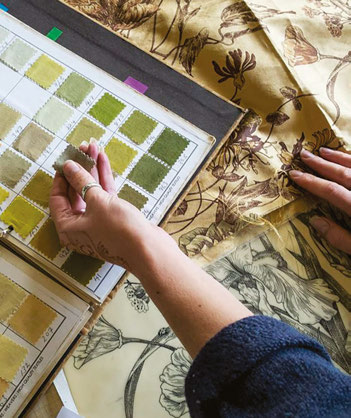Timeless Textiles
Marina Mill is a Kent-based, family business that specialises in designing and producing exclusive furnishing fabrics.
Following a Fine Art education and several years working with Zika Ascher, Keith Rawkins and his wife, Stephanie, set up their business in 1967 to design textiles for the fashion boutiques of Swinging London. They began by hand-printing fabrics from a basement flat in Fulham and were soon supplying many famed fashion couturiers of the day. A few specially designed commissions for private residences and boutique hotels in the mid-1970s gradually changed the focus from fashion to interiors.




Keith and Steph were joined by their son, Guy, and their daughter, Tandine, in the late 1980s, by which time they were developing their own ranges of exclusive hand-printed furnishing fabrics.
Marina Mill relocated to the current premises in the early 1990s; an old Victorian mill on the banks of the River Medway in Kent. This move coincided with lucrative projects to design and produce fine interior fabrics for production motoryachts and thereafter to the most prestigious superyachts.
Design Archive
Marina Mill have been creating bespoke textiles for nearly 50 years and have a vast archive of print designs available. Hundreds of designs exist on screen, stored in their onsite Victorian sheds, along with thousands of sketches, drawings and finished ideas on the shelves of our extensive library.
Using all these sources, they regularly collaborate with clients on projects, to produce precisely the right fabric for their collection or scheme.
All the fabrics are conceived, designed and hand drawn by them in their studio at the Mill. They produce every stage of the design process from the sketch to the draft film to the final colouration.
The studio cupboards are full of printed samples on various fine basecloths, offered as inspiration and examples of their finely executed design work and highest quality hand-printing. Good design is of paramount importance to Marina Mill and all their fabrics are conceived, designed and hand-drawn by them in our studio at the mill.
The Creative Process
All the artwork is done by hand. A skilled hand-drawing has a unique quality, unmatched by computer generated or digitally produced work.
The design process begins with freehand sketches and hand-painted ideas on paper, which are then developed into repeating patterns. Reference books are often utilised if a specific style is required or we may refer to antique documents for historical replication projects.
The colour balance is a crucial part of the creative process at this stage. Multi-coloured patterns require careful calculation and visual consideration.
Colour Separations
Once pattern repeats are worked out, colour separations are traced off by hand from the original design onto draft film, using pen and ink. When the full-width films are completed, they are used to engrave the design onto the ‘silk’ screen, via a basic photographic process.
Colouring Up
Now the fun starts! Once the screens are made, the sampling process can begin. Print colours can be selected from the extensive standard range, along with basecloths from the natural, pure finish collection of linens, silks and cottons. Samples are then printed for customers’ approval.
Custom Colours
If a specific print colour is required to coordinate with a client’s scheme, Marina Mill’s expert colour mixers can create one. They can match to anything, from a cashmere sweater to a carpet tuft!
Hand-Print Process
Marina Mill’s printed fabrics make up the core of the business and are all printed entirely by hand in their old Victorian mill on the banks of the River Medway in Kent. Here, they have four 25 metre long tables and print using the traditional silk screen method; no machinery or automation is involved in the print process whatsoever. They have a highly skilled team that has been extensively trained in all aspects of hand-printing, colour mixing and screen-making to become experts in their field.
Colour Mixing by Eye
The company’s expert colour mixers blend various pure pigments with binders to match any given sample by eye, thus enabling infinite colour combinations. Only harmless water-based pigments are used in the print colours, to protect the local environment.
Calibrating
The selected basecloth is pulled taut and pinned down by hand onto one or more of the padded print tables. Then the screen repeat of the chosen design is measured out and secured along the length of the steel edge rail using metal peg markers.
Applying the Colour
The first screen is placed in position on top of the basecloth at one end of the table then the pre-mixed colour is poured into the screen by the lead printer. The application is made by this printer using a squeegee to push the colour across the screen (through the image engraved in the mesh) to the printer opposite.
The screen is then lifted and relocated in its next position along the table and the squeegee passed across again. This process is repeated until the whole length of fabric is printed with this first colour.
Washing the Screen
After each screen has been printed, the remaining colour is collected for re-use and that screen is carefully washed with water in a hosing bay. The pigments used are water-based and therefore environmentally friendly so can be safely washed away.
Drying Time
After each colour is laid down, the fabric is dried by highly efficient, overhead, infra-red heaters.
Completion
When the printing is finished and dried, the fabric is unpinned by hand, cut to the desired length, rolled up and removed from the table for the final process.
Curing
The printed fabric is then slowly fed through a baking tunnel on a conveyor belt. This is set at a specific high temperature, which heat-fixes the print to the basecloth.
Ready for Despatch
The roll of fabric is then passed through a final inspection and packaged for despatch.
For more information visit www.marinamill.co.uk
Posted in: Features





